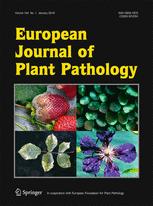Ver ítem
- xmlui.general.dspace_homeCentros e Institutos de InvestigaciónCIAP. Centro de Investigaciones AgropecuariasInstituto de Patología VegetalArtículos científicosxmlui.ArtifactBrowser.ItemViewer.trail
- Inicio
- Centros e Institutos de Investigación
- CIAP. Centro de Investigaciones Agropecuarias
- Instituto de Patología Vegetal
- Artículos científicos
- Ver ítem
Geographical distribution and first molecular detection of an Emaravirus, High Plains wheat mosaic virus, in Argentina
Resumen
High Plains wheat mosaic virus (HPWMoV) has recently been assigned to genus Emaravirus and is the causal agent of High Plains disease. In this work the geographical distribution and first molecular detection of HPWMoV in Argentina are reported. The virus was detected in six provinces and nine hosts, including wheat, corn, oat and barley, as well as weeds, which play an important role in the epidemiology of this disease. Molecular and phylogenetic analyses
[ver mas...]
High Plains wheat mosaic virus (HPWMoV) has recently been assigned to genus Emaravirus and is the causal agent of High Plains disease. In this work the geographical distribution and first molecular detection of HPWMoV in Argentina are reported. The virus was detected in six provinces and nine hosts, including wheat, corn, oat and barley, as well as weeds, which play an important role in the epidemiology of this disease. Molecular and phylogenetic analyses of a portion of RNA3 nucleoprotein gene sequence showed that five HPWMoV isolates from different wheat growing regions of Argentina were identical, and suggest a single introduction of HPWMoV to this country, possibly through corn seeds. To the best of our knowledge, this is the first molecular detection of HPWMoV in South America. These results highlight the importance of certification of viruses-free cereal seeds and strict controls for material transfer between different countries to prevent the entry not only of new pathogens but also of new variants or strain at sites where the pest has already been detected.
[Cerrar]

Fuente
European journal of plant pathology 149 (3) : 743–750. (November 2017)
Fecha
2017-11
Editorial
Springer
ISSN
0929-1873
1573-8469 (Online)
1573-8469 (Online)
Formato
pdf
Tipo de documento
artículo
Palabras Claves
Derechos de acceso
Restringido
 Excepto donde se diga explicitamente, este item se publica bajo la siguiente descripción: Creative Commons Attribution-NonCommercial-ShareAlike 2.5 Unported (CC BY-NC-SA 2.5)
Excepto donde se diga explicitamente, este item se publica bajo la siguiente descripción: Creative Commons Attribution-NonCommercial-ShareAlike 2.5 Unported (CC BY-NC-SA 2.5)

